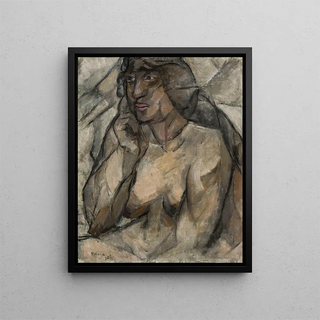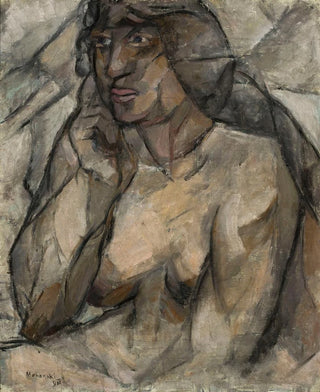Art print | Study of a half-naked woman - Tadeusz Makowski Source: Reproduction | Étude d'une femme nue à moitié nue - Tadeusz Makowski


View from behind

Frame (optional)
In the vast panorama of modern art, certain works stand out for their ability to capture the essence of human beauty and the complexity of the soul. The art print of Étude d'une femme nue à moitié nue - Tadeusz Makowski is a striking example. This painting, both delicate and bold, invites us to delve into a universe where sensuality and vulnerability intertwine. The artist, through his unique approach, manages to transcend mere representation to offer us a reflection on the human condition. Contemplating this piece, the viewer is transported into an intimate dialogue with the female figure, an experience that goes far beyond simple observation.
Style and uniqueness of the work
Tadeusz Makowski's work is distinguished by a refined aesthetic, imbued with a sensitivity that is both modern and timeless. In the art print of Étude d'une femme nue à moitié nue, the artist skillfully plays with forms and colors to create an atmosphere that is both gentle and unsettling. The flowing lines and subtle nuances of the skin evoke a palpable sensuality, while the choice of lighting accentuates the volumes and shadows, giving unprecedented depth to the composition. This painting is not limited to a mere bodily representation; it reflects the emotions and thoughts that inhabit the depicted woman. Far from being a passive object of contemplation, she becomes a symbol of strength and fragility, an embodiment of beauty in its rawest truth.
The artist and his influence
Tadeusz Makowski, Polish painter of the early 20th century, managed to establish a link between tradition and modernity. Trained in prestigious European academies, he developed a style that combines the influence of old masters with an innovative vision. His ability to capture moments of life, pure emotions, and intimate atmospheres marked his era and continues to inspire many contemporary artists. The depiction of women in his work, far from merely objectifying, testifies to a deep respect and admiration for the complexity of femininity. Makowski, through his unique perspective, reminds us how

Matte finish

View from behind

Frame (optional)
In the vast panorama of modern art, certain works stand out for their ability to capture the essence of human beauty and the complexity of the soul. The art print of Étude d'une femme nue à moitié nue - Tadeusz Makowski is a striking example. This painting, both delicate and bold, invites us to delve into a universe where sensuality and vulnerability intertwine. The artist, through his unique approach, manages to transcend mere representation to offer us a reflection on the human condition. Contemplating this piece, the viewer is transported into an intimate dialogue with the female figure, an experience that goes far beyond simple observation.
Style and uniqueness of the work
Tadeusz Makowski's work is distinguished by a refined aesthetic, imbued with a sensitivity that is both modern and timeless. In the art print of Étude d'une femme nue à moitié nue, the artist skillfully plays with forms and colors to create an atmosphere that is both gentle and unsettling. The flowing lines and subtle nuances of the skin evoke a palpable sensuality, while the choice of lighting accentuates the volumes and shadows, giving unprecedented depth to the composition. This painting is not limited to a mere bodily representation; it reflects the emotions and thoughts that inhabit the depicted woman. Far from being a passive object of contemplation, she becomes a symbol of strength and fragility, an embodiment of beauty in its rawest truth.
The artist and his influence
Tadeusz Makowski, Polish painter of the early 20th century, managed to establish a link between tradition and modernity. Trained in prestigious European academies, he developed a style that combines the influence of old masters with an innovative vision. His ability to capture moments of life, pure emotions, and intimate atmospheres marked his era and continues to inspire many contemporary artists. The depiction of women in his work, far from merely objectifying, testifies to a deep respect and admiration for the complexity of femininity. Makowski, through his unique perspective, reminds us how






